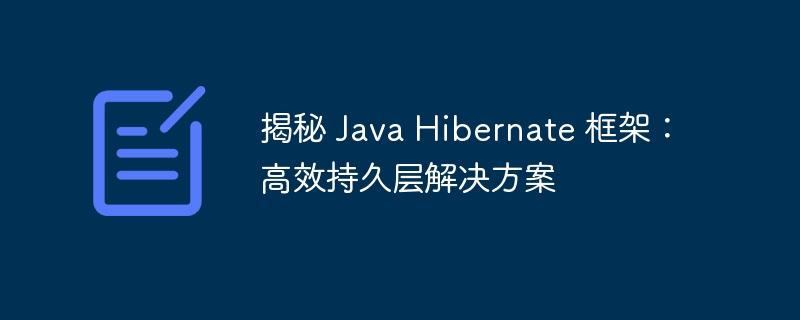

php Xiaobian Xigua takes you to reveal the Java Hibernate framework: an efficient persistence layer solution. Hibernate is a popular ORM (Object Relational Mapping) framework that can simplify database operations and improve development efficiency. Through Hibernate, developers can use an object-oriented approach to operate the database, avoid writing SQL statements directly, and at the same time achieve cross-database compatibility. This article will delve into the features, advantages, and usage techniques of the Hibernate framework to help you better understand and apply this powerful Java framework.
Java Hibernate Framework is an open sourceORM framework that can map Java objects to database tables and provide A series of operations on the api of the database. It can help you simplify database operations and improve development efficiency.
2. Basic concepts of Hibernate
The core concept of Hibernate is persistent objects. Persistence objects are subclasses of Java objects that can be mapped to database tables by Hibernate. When you save a persistent object, Hibernate automatically updates the object's state to the database. When you query a persistent object from the database, Hibernate automatically loads the object's property values into an instance of the object.
3. How Hibernate works
Hibernate manages database connections and persistence objects through an object called SessionFactory. SessionFactory is a heavyweight object that is created when the application starts and destroyed when the application closes. SessionFactory can create multiple Session objects. Session is a lightweight object that represents a database connection.
When you need to operate the database, you need to create a Session object first, and then use the Session object to create or query persistence objects. When you're done, you need to close the Session object.
4. Advantages of Hibernate
The advantages of Hibernate include:
5. Disadvantages of Hibernate
Disadvantages of Hibernate include:
6. Hibernate application scenarios
Hibernate can be used in various types of applications, such as:
7. Conclusion
Hibernate is an excellent ORM framework that can help you simplify database operations and improve development efficiency. The advantages of Hibernate include ease of use, improved development efficiency, improved application performance, and increased application portability. Disadvantages of Hibernate include a steep learning curve, performance overhead, and complexity. Hibernate can be used in various types of applications such as web applications, desktop applications, and mobile applications.
The above is the detailed content of Demystifying the Java Hibernate Framework: An Efficient Persistence Layer Solution. For more information, please follow other related articles on the PHP Chinese website!
